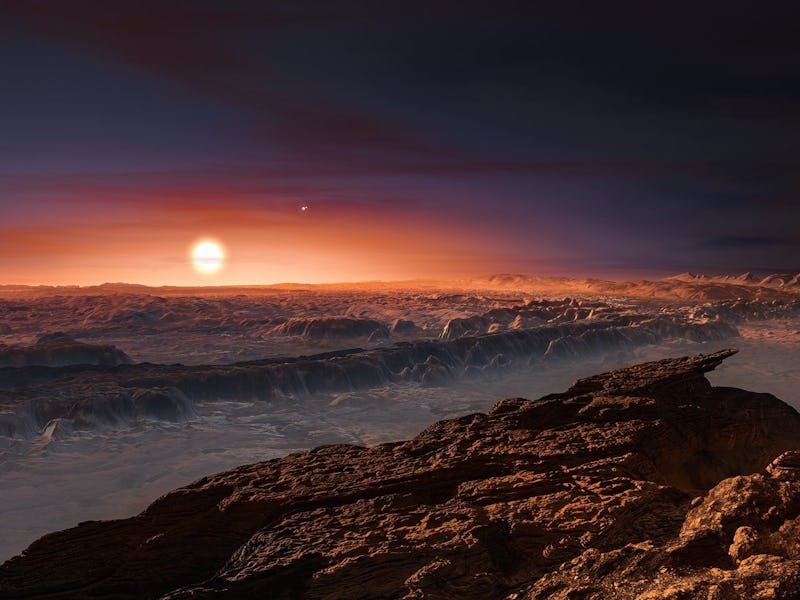This New Exoplanet Could Be the Next Earth and It's Very Close
Proxima is next door, at just 4.25 light-years away.

Early last week, a rumor rumbled within the space community that astronomers had stumbled on a potentially habitable planet orbiting Proxima Centauri: a red dwarf star just 4.25 light-years away, making it the nearest star to Earth that’s not the sun. If true, it would mean we may just be a stone’s throw away from an Earth-like world — the closest possible Earth 2.0.
According to findings published online in Nature on Wednesday, there’s an exoplanet orbiting Proxima Centauri within the Goldilocks zone, the orbital region that’s not too close or far from a sun with an amenable atmosphere for humans and the potential for liquid water.
Artist’s impression shows the planet Proxima b orbiting the red dwarf star Proxima Centauri, the closest star to the Solar System.
Proxima Centauri’s planet, dubbed Proxima b, is about 1.3 times mass of Earth — making it “very likely it has a rocky composition,” study coauthor Michael Endl, an astronomer at the University of Texas at Austin, tells Inverse. He says while there’s a chance the Proxima b is a “super Earth,” he estimates a 90 percent chance the planet is at least less than three Earth masses, which is thought to be the maximum mass threshold for a planet to sustain life as we know it.
Proxima b was found thanks to the Pale Red Dot campaign initiated by study lead Guillem Anglada-Escudé, an astronomer based at Queen Mary University of London. The project basically involved nightly observations of Proxima Centauri using the HARPS spectrograph on the European Southern Observatory’s 3.6-meter telescope located at La Silla, Chile. The goal was to look for a wobble within the star that would be a sign of a large celestial body creating a gravitational effect as a result of its orbit.
After a long search and a comparison with archival data from the last couple of decades, Anglada-Escudé and his colleagues confirmed such a wobble, and were able to pinpoint the Proxima b’s presence within the star’s Goldilocks zone.
Besides being so close to Earth, the new discovery underscores the excitement surrounding habitability around red dwarf stars. Long thought to be too small and cool to encourage habitable worlds, red dwarfs are now a serious focus for exoplanet researchers. Comprising 80 to 90 percent of the stars in the Milky Way, finding a planet around Proxima Centauri is “very good news” for those hoping habitable planets could be everywhere, says Endl.
Endl emphasizes that right now, “we know relatively little about the planet itself.” Confirming that it resides in Proxima Centauri’s Goldilocks zone simply means we know its orbital period and mass. We’re still not sure about Proxima b’s atmospheric composition and pressure, geological composition, actual surface temperatures, and tons of other traits important to habitability. In other words: Don’t pack your bags yet.
Fortunately, “this discovery opens the door to possibly answer all those questions,” says Endl.
The next step for assessing what kind of world Proxima b will be depends on whether or not we can observe its stellar transit or not (meaning, whether our telescopes can watch the planet move past Proxima Centauri and measure the dimming and brightening of the star in the process).
If the new planet has a stellar transit we can observe, Endl says we can use transmission spectroscopy to investigate other habitable traits and the presence of biosignatures in greater detail.
If there is no transit, however, follow-up studies will be a bit more difficult. Endl and his colleagues will work to figure out if they can directly image Proxima b using other instruments. Normally this is impossible to do on exoplanets because of the sheer distance separating us from them. However, the short 4.25 light-year jaunt means current and emerging imaging techniques could perhaps easily observe the planet and measure traits relevant to habitability. Radio velocity measurements would also prove extremely useful.
Nevertheless, there are certain parts of Proxima Centauri’s planet that we can only study by actually going there. Humans are still complete novices when it comes to interstellar travel, but the Stephen Hawking led Breakthrough Starshot initiative — which aims to send hundreds of solar-sail fitted nanocraft to nearby Alpha Centauri (which may be gravitationally related to Proxima Centauri) to observe any potential planets in the area and see how habitable they might be. The new findings will perhaps persuade Hawking and his team to pivot the project towards Proxima Centauri and Proxima b — or at the very least, reserve a couple dozen of those spacecraft to head for the red dwarf.
In any case, the discovery of Proxima b — so tantalizingly close to Earth — is incredible news for extraterrestrials enthusiasts around the world. As Endl put it, “It’s just perfect.”